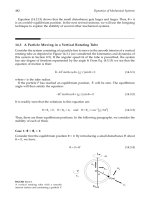Organ systems OS set 11 gastroenterology question
Bạn đang xem bản rút gọn của tài liệu. Xem và tải ngay bản đầy đủ của tài liệu tại đây (87.95 KB, 3 trang )
High Yield Warm-up Questions: Gastroenterology
ORGAN SYSTEMS SET 11: GASTROENTEROLOGY
1.
Name the parts of the gut that form the beginning and end of the foregut, midgut and hindgut.
2.
Name two anterolateral body wall defects through which parts of the gut may protrude postnatally.
3.
Compare and contrast the causes and clinical presentations of an infant born with a tracheoesophageal fistula
versus duodenal atresia.
4.
List the four fundamental processes in gastrointestinal physiology.
5.
Discuss the cellular regulation of pancreatic bicarbonate secretion and the primary hormone that stimulates
this secretion.
6.
Discuss the enterohepatic circulation and its role in fat digestion.
1
High Yield Warm-up Questions: Gastroenterology
7.
Compare and contrast the parotid, submandibular and sublingual glands in terms of differences in the saliva
that they produce and the parasympathetic nerves that innervate them.
8.
Name the pairs of arteries that provide the dual arterial blood supply to the greater versus the lesser curvature
of the stomach.
9.
Compare and contrast the secretory products and functions of parietal and chief cells in the stomach.
10. Name some risk factors that cause an increased risk for peptic ulcer disease.
11. What are several complications that can occur with Crohn’s disease?
12. After a patient develops colon cancer at age 26, the other members of the family undergo colonoscopy. Several
family members are found to have thousands of small adenomatous polyps in their colons. What is the location
of the gene that is most likely causing the polyps?
2
High Yield Warm-up Questions: Gastroenterology
13. Compare and contrast the source, stimulus and actions of gastrin, CCK, and secretin.
14. Compare and contrast the functions of Zone 1 versus Zone 3 hepatocytes in a liver acinus.
15. Compare and contrast the different functions of Kupffer and Ito cells.
16. What types of endocrine products can be produced by tumors derived from the pancreatic islets?
17. Briefly describe the histology of cirrhosis.
18. Which hepatitis B antibody is used as an important indicator of transmissibility?
These question sets are intended to be completed before viewing the High Yield course lectures.
Video explanations can be found on the Warm-up Questions page within the online High Yield course.
For further review of the topics covered in this set, refer to the following lectures:
Gastroenterology:
• Gastroenterology: Embryology and Associated Disorders
• Gastroenterology: Anatomy, Histology, and Physiology
• Gastrointestinal Pathology
• Liver and Pancreas Pathology
3









